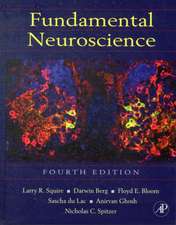Animal Models of Movement Disorders: Volume I: Neuromethods, cartea 61
Editat de Emma L. Lane, Stephen B. Dunnetten Limba Engleză Hardback – 15 sep 2011
Comprehensive and meticulous, Animal Models of Movement Disorders serves as a valuable reference for those studying motor disorders by covering methodologies in detail and providing the information necessary to consider both the appropriate models and assessment tools that can most informatively answer the key experimental issues in the field.
| Toate formatele și edițiile | Preț | Express |
|---|---|---|
| Paperback (2) | 710.23 lei 6-8 săpt. | |
| Humana Press Inc. – 23 aug 2016 | 710.23 lei 6-8 săpt. | |
| Humana Press Inc. – 23 aug 2016 | 710.56 lei 6-8 săpt. | |
| Hardback (2) | 965.52 lei 6-8 săpt. | |
| Humana Press Inc. – 15 sep 2011 | 965.52 lei 6-8 săpt. | |
| Humana Press Inc. – 8 sep 2011 | 965.52 lei 6-8 săpt. |
Din seria Neuromethods
- 5%
 Preț: 347.58 lei
Preț: 347.58 lei - 15%
 Preț: 659.53 lei
Preț: 659.53 lei - 15%
 Preț: 665.08 lei
Preț: 665.08 lei - 18%
 Preț: 986.63 lei
Preț: 986.63 lei - 18%
 Preț: 953.03 lei
Preț: 953.03 lei - 18%
 Preț: 955.25 lei
Preț: 955.25 lei - 20%
 Preț: 1129.39 lei
Preț: 1129.39 lei - 20%
 Preț: 1252.07 lei
Preț: 1252.07 lei - 18%
 Preț: 1291.45 lei
Preț: 1291.45 lei - 15%
 Preț: 652.31 lei
Preț: 652.31 lei - 18%
 Preț: 955.70 lei
Preț: 955.70 lei - 23%
 Preț: 705.40 lei
Preț: 705.40 lei - 18%
 Preț: 973.38 lei
Preț: 973.38 lei - 18%
 Preț: 964.86 lei
Preț: 964.86 lei - 18%
 Preț: 968.03 lei
Preț: 968.03 lei - 15%
 Preț: 662.95 lei
Preț: 662.95 lei - 15%
 Preț: 646.43 lei
Preț: 646.43 lei - 15%
 Preț: 649.71 lei
Preț: 649.71 lei -
 Preț: 395.29 lei
Preț: 395.29 lei - 19%
 Preț: 580.68 lei
Preț: 580.68 lei - 19%
 Preț: 584.13 lei
Preț: 584.13 lei - 19%
 Preț: 566.41 lei
Preț: 566.41 lei - 15%
 Preț: 652.17 lei
Preț: 652.17 lei - 15%
 Preț: 655.13 lei
Preț: 655.13 lei - 18%
 Preț: 1009.58 lei
Preț: 1009.58 lei - 18%
 Preț: 959.36 lei
Preț: 959.36 lei - 15%
 Preț: 652.49 lei
Preț: 652.49 lei - 15%
 Preț: 649.54 lei
Preț: 649.54 lei - 15%
 Preț: 649.87 lei
Preț: 649.87 lei - 15%
 Preț: 650.19 lei
Preț: 650.19 lei - 15%
 Preț: 648.42 lei
Preț: 648.42 lei - 18%
 Preț: 1039.22 lei
Preț: 1039.22 lei - 18%
 Preț: 963.15 lei
Preț: 963.15 lei
Preț: 965.52 lei
Preț vechi: 1177.46 lei
-18% Nou
Puncte Express: 1448
Preț estimativ în valută:
184.74€ • 192.91$ • 152.56£
184.74€ • 192.91$ • 152.56£
Carte tipărită la comandă
Livrare economică 15-29 aprilie
Preluare comenzi: 021 569.72.76
Specificații
ISBN-13: 9781617792977
ISBN-10: 1617792977
Pagini: 425
Ilustrații: XV, 447 p.
Dimensiuni: 178 x 254 x 30 mm
Greutate: 1.02 kg
Ediția:2012
Editura: Humana Press Inc.
Colecția Humana
Seria Neuromethods
Locul publicării:Totowa, NJ, United States
ISBN-10: 1617792977
Pagini: 425
Ilustrații: XV, 447 p.
Dimensiuni: 178 x 254 x 30 mm
Greutate: 1.02 kg
Ediția:2012
Editura: Humana Press Inc.
Colecția Humana
Seria Neuromethods
Locul publicării:Totowa, NJ, United States
Public țintă
Professional/practitionerCuprins
Why Can’t a Rodent Be More like a Man?: A Clinical Perspective.- Zebrafish as a Vertebrate Model Organism for Studying Movement Disorders.- Methodological Strategies to Evaluate Functional Effectors Related to Parkinson’s Disease through Application of C. elegans Models.- Effects of Alpha-Synuclein Expression on Behavioral Activity in Drosophila, a Simple Model of Parkinson’s Disease.- Neurological Evaluation of Movement Disorders in Mice.- Rodent Skilled Reaching for Modeling Pathological Conditions of the Human Motor System.- High Throughput Mouse Phenotyping.- MRI of Neurological Damage in Rats and Mice.- Quantification of Brain Function and Neurotransmission System In Vivo by Positron Emission Tomography: A Review of Technical Aspects and Practical Considerations in Preclinical Research.- Optical Approaches to Studying the Basal Ganglia.- Electrophysiological Analysis of Movement Disorders in Mice.- Genetic Models of Parkinson`s Disease.- 6-OHDA Lesion Models of Parkinson’s Disease in the Rat.- 6-OHDA Toxin Model in Mouse.- Rotation in the 6-OHDA Lesioned Rat.- Of Rats and Patients: Some Thoughts about Why Rats Turn in Circles and Parkinson’s Disease Patients Cannot Move Normally.- Comparing Behavioral Assessment of Sensorimotor Function in Rat and Mouse Models of Parkinson’s Disease and Stroke.- Rodent Models of L-DOPA-Induced Dyskinesia.- Using the MPTP Mouse Model to Understand Neuroplasticity: A New Therapeutic Target for Parkinson’s Disease?.- The MPTP Treated Primate, with Specific Reference to the Use of the Common Marmoset (C. jacchus).- Behavioral Assessment in the African Green Monkey after MPTP Administration.
Textul de pe ultima copertă
Movement is the way that animals interact with their environment and is under the organization and complex control of the brain and spinal cord. Multiple central nervous systems, including cortex, basal ganglia, cerebellum, and brainstem, interact to provide precise motor control and integration. Damage or disease within these systems cause profound motor disturbances in man, which can be effectively modeled in animals to develop a better understanding and treatment of the human condition. Animal Models of Movement Disorders introduces a variety of methods and techniques used to model and assess motor function in experimental animals from lower orders, such as drosophila and c. elegans, through vertebrate species including fish, to mammals, such as rodents and non-human primates. The most advanced contemporary models in each system are presented at multiple levels of analysis from molecular and genetic modeling, lesions, anatomy, neurochemistry, to imaging and behavior. Volume I contains general methods of movement disorder assessment as well as an extensive section on dopamine systems.
Comprehensive and meticulous, Animal Models of Movement Disorders serves as a valuable reference for those studying motor disorders by covering methodologies in detail and providing the information necessary to consider both the appropriate models and assessment tools that can most informatively answer the key experimental issues in the field.
Comprehensive and meticulous, Animal Models of Movement Disorders serves as a valuable reference for those studying motor disorders by covering methodologies in detail and providing the information necessary to consider both the appropriate models and assessment tools that can most informatively answer the key experimental issues in the field.
Caracteristici
Serves as a comprehensive and valuable reference for those studying motor disorders Provides appropriate models and assessment tools Includes clear, easy to follow methods with expert implementation advice















